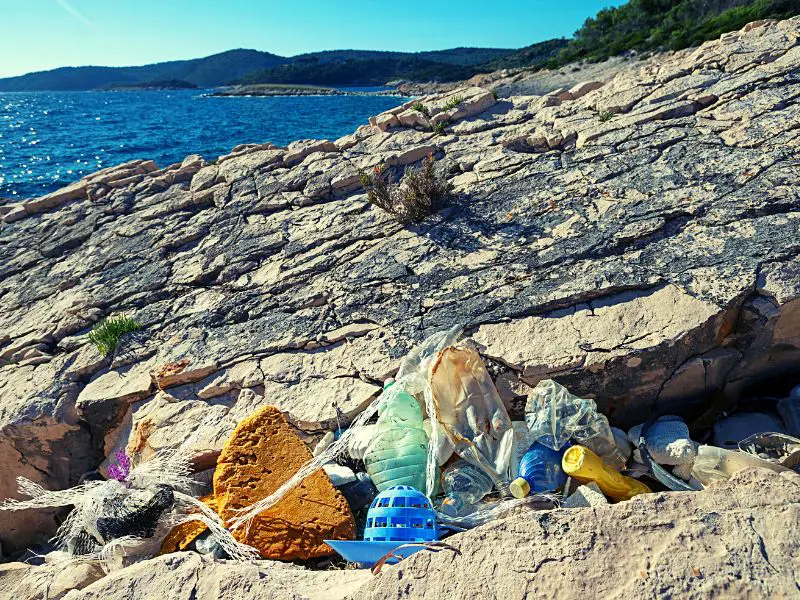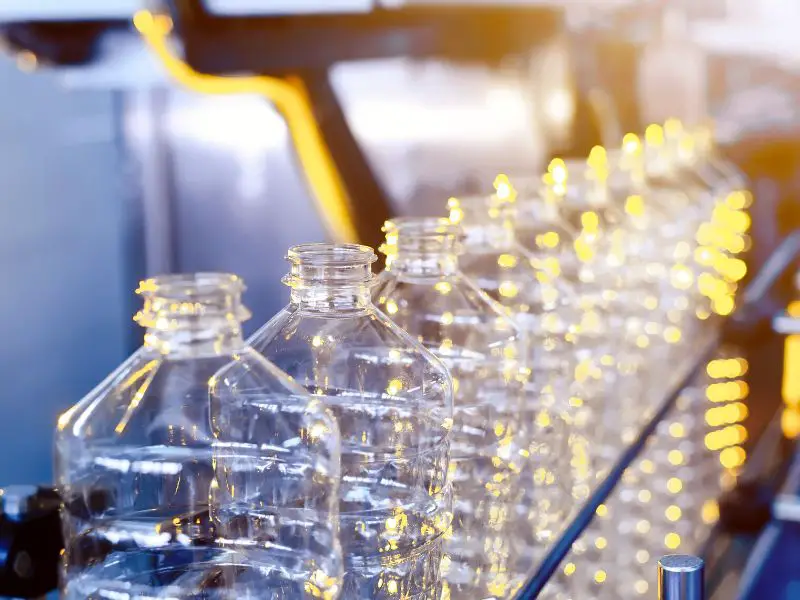You’ve undoubtedly heard about a lot of plastic in the water, but did you know about The Great Pacific Garbage Patch, a vortex of garbage in the ocean? Do you know where this comes from and what remedies are being suggested or developed today?
In this article, we’ll dive into things you need to know about the Great Pacific Garbage Patch.
The Great Pacific Garbage Patch
The Great Pacific Garbage Patch is floating trash bigger than the size of Texas. In 2014, Moore’s expedition estimated that the amount of garbage was 100x times more than previously measured. The team also found permanent plastic islands, some more than 15 meters (50 feet) in length. A floating landfill in the midst of the ocean doesn’t sound so attractive, does it?

“The Great Pacific Garbage Patch is a wake-up call to the world that we need to take urgent action to reduce our plastic consumption and waste.”
– United Nations Environment Programme
Where Is It Located?
The Great Pacific Garbage Patch, also known as the Pacific Garbage Vortex, extends from the west coast of North America to Japan. The patch consists of the Western Garbage Patch, situated close to Japan, and the Eastern Garbage Patch, found between Hawaii and California.
A few hundred kilometers north of Hawaii, the North Pacific Subtropical Convergence Zone links these bands of whirling debris. This convergence zone is when water from the South Pacific and the Arctic collide. This zone is a highway transporting trash from one patch to the next.
How Did It Accumulate?
Most trash that accumulates in the Great Pacific Garbage Patch is not biodegradable. Many plastics don’t wear down; they just break into smaller and smaller pieces.
For many, the idea of a “garbage patch” conjures thoughts of a floating island of garbage in the middle of the ocean. In truth, these patches are composed of tiny bits of plastics, sometimes invisible to the human eye, often known as microplastics. Satellite imaging can’t even reveal these massive waste dumps. The water here actually looks like a muddy soup. This soup has larger debris, like fishing gear, shoes, and nets. The floor under is an absolute trash heap. Recent research by ecologists and oceanographers discovered that roughly 70% of marine trash sinks to the ocean’s bottom.
How Much Debris Is There?
No one knows exactly how much debris makes up the GPGP. The Subtropical North Pacific Gyre is too vast for scientists to scour. Plus, not all this trash floats on the water. Much bigger debris can sink centimeters or several meters to the ocean floor, making the vortex area almost impossible to gauge.
However, some estimate that the garbage here is about 80,000 tonnes or 400 Jumbo Jets, 4-16x the previous calculations. But note that the research only covers the denser area or the center. The same research estimated that the GPGP has 1.8 trillion plastic pieces. This is equivalent to nearly 250 pieces of plastic debris for every individual worldwide.
Marine Debris Is Harmful to Marine Life
Marine Debris is of utmost destruction to marine life, especially in the vortex. For example, sea creatures, like loggerheads, can mistakenly eat plastics, knowing their jellies, their favorite food. Albatrosses misinterpret plastic pellets for fish eggs and feed them to their babies, causing malnutrition or organ rupture.

“The Great Pacific Garbage Patch is a tragedy that shows the devastating impact of human activity on our oceans.”
– Greenpeace
Humans are no exception to the dangers of the Great Pacific Garbage Patch. Microplastics have been discovered in the stomachs of about half of the most consumed fish by humans. This implies we may be eating our own garbage.
The Silent Battle in the North Pacific and the Great Pacific Garbage Patch
The vast expanse of the Pacific Ocean, particularly the north pacific region, often evokes images of serene blue waters and endless horizons. However, beneath this tranquil façade, there lies a pressing problem.
“The Great Pacific Garbage Patch is a reminder that we need to take urgent action to protect our oceans and the marine life that depends on them.”
– The Guardian
The North Pacific Ocean is grappling with a monstrous aggregation of debris, predominantly made up of plastic waste. This vast expanse of pollutants, also known as the Great Pacific Garbage Patch, serves as a stark reminder of the rampant plastic pollution currently plaguing our planet.
Understanding the Vortex of Debris and the Great Pacific Garbage Patch
The open expanse of the open ocean isn’t untouched by human actions. The North Pacific Ocean, through its intricate web of ocean currents, accumulates and ensnares a large amount of the world’s ocean trash, culminating in what we know as the Great Pacific Garbage Patch. This plastic soup consists of items ranging from fishing nets, fishing gear, and plastic bags to minute microplastics, showcasing the dense concentration of pollutants.
Regions like the Eastern Garbage Patch are just subsets of the larger Great Pacific Garbage Patch, reflecting the vast spread of ocean plastic pollution in the waters.
The Champions of the Ocean Cleanup
Organizations like the Ocean Cleanup Foundation and the Ocean Voyages Institute have recognized the enormity of the Great Pacific Garbage Patch and have taken significant strides in addressing it. Their innovative approaches and dedication have resulted in the extraction of tons of plastic waste, inclusive of the notorious “ghost” fishing nets.
Marine ecologist Linsey Haram has also been instrumental in highlighting the severity of the Great Pacific Garbage Patch. Her work in the North Pacific has been pivotal in bringing about a global awareness of this issue.
A Deeper Dive into the Ocean’s Condition
The National Oceanic and Atmospheric Administration, or atmospheric administration, has provided invaluable insights into the complexities of the Great Pacific Garbage Patch.
Through their research, it’s evident that larger items like fishing gear and floating plastic are just the tip of the iceberg. Beneath the surface lies a vast network of microplastics that are almost omnipresent in the north pacific region.
Proactive Measures for a Cleaner Ocean
Addressing the Great Pacific Garbage Patch requires a dual approach: Cleanup and Prevention. While the mantra of Reduce, Reuse, and Recycle isn’t new, its diligent application can make a significant dent in the size of the Great Pacific Garbage Patch. Embracing biodegradable options, ensuring fishing gear is responsibly managed, and reducing our reliance on plastic are vital steps in this direction.
The Road Ahead
The enormity of the Great Pacific Garbage Patch can be daunting. However, global action and awareness can usher in a new era of oceanic conservation. As stewards of the Earth, our focus should not only be on the pristine areas of the Pacific Ocean but also on the troubled waters of the Great Pacific Garbage Patch, ensuring its restoration for future generations.
Some Actions That Are Being Done
1. Clean-Up Efforts
Cleaning debris from water is not as easy as it sounds. However, several individuals and international organizations are committed to stopping the patch’s growth. The effort to clean out the gyre is threefold: collecting pollutants in the environment, recycling and reusing plastics to prevent reaching waterways, and restricting the manufacture of plastic production(as well as curbing the strong demand)
Here are some companies that strive to solve this massive problem.
- The Clen Seas Campaign: A global effort led by the United Nations Environment Programme to stop the spread and reduce marine litter.
- The Ocean Cleanup: Run by a Dutch inventor, the ocean cleanup is a well-known effort of the GPGP initiative.
Related: 10 Amazing Organizations Fighting Ocean Pollution, 8 Worst Polluted Beaches In The World, 10 Tips to Habitually Conserve Water
2. Recycling
It is better to prevent plastics from entering the stream than to clean up the problem afterward. This requires lowering or eliminating 90% of single-use plastics and boosting the present recycling rate of plastics from 9% to a higher percentage (only 14% is initially collected, to begin with). Since 1991, nations, states, and municipalities have implemented regulations to minimize or ban the use of single-use plastic bags.
As a result of enforcing a fee on single-use plastic bags, for example, the United Kingdom observed a significant reduction in offshore waste. Making people who make plastic pollution pay for it can also help more people recycle. Norway’s pioneering program of charging bottling businesses if plastic bottle recycling rates fall below 95% has resulted in recycling 97% of its country’s bottles.
3. Limit Production
Cleanup can help reduce the amount of plastic pollution, and recycling can help cut down on the amount of plastic trash, but neither of these efforts can keep up with the rate of plastic production, which has increased from about 1.5 million tons in 1950 to 348 million tons in 2017.
Like the carbon tax, the plastic tax can help people recycle and use less. Maine was the first U.S. state to make companies that use single-use packaging pay for the cost of recycling. Those costs will, of course, be passed on to the consumers making them reuse more. It is also essential to have laws that encourage people to use reusable packaging instead of single-use, throw-away packaging.

Author’s Note
If we continue to dump trash in the ocean, the problem will never be solved, and the great Pacific garbage patch will continue to get bigger and bigger. Each one of us as individuals can do our part by stopping using disposable plastic bags and encouraging others to do the same.
We can support organizations that actively work against the growth of the GPGP and educate them about the need to save our oceans. We need to limit the production of plastic waste and stop making it disposable in the first place.
The sea has so much to give, but if we keep taking without replenishing it, we will have nothing left.


2 thoughts on “Great Pacific Garbage Patch: What You Need to Know to Save Our Oceans”